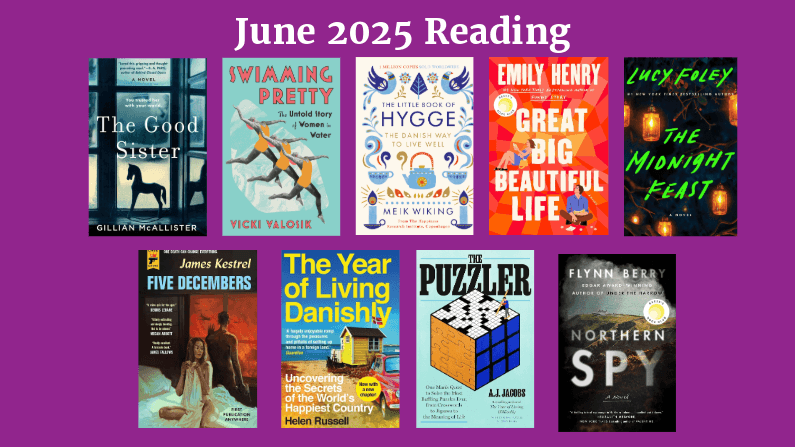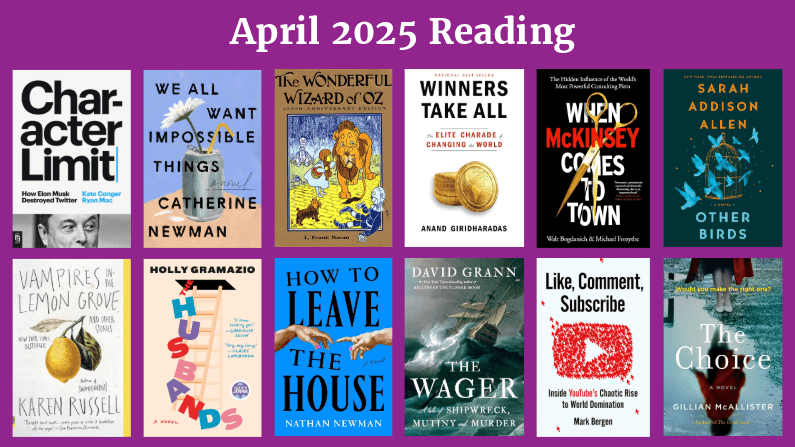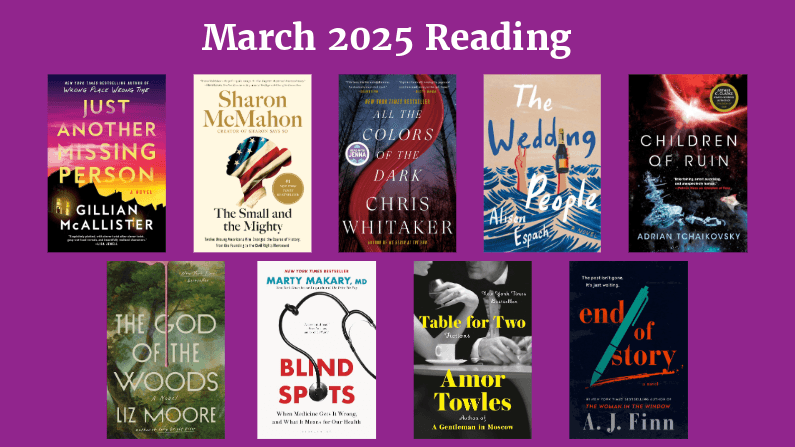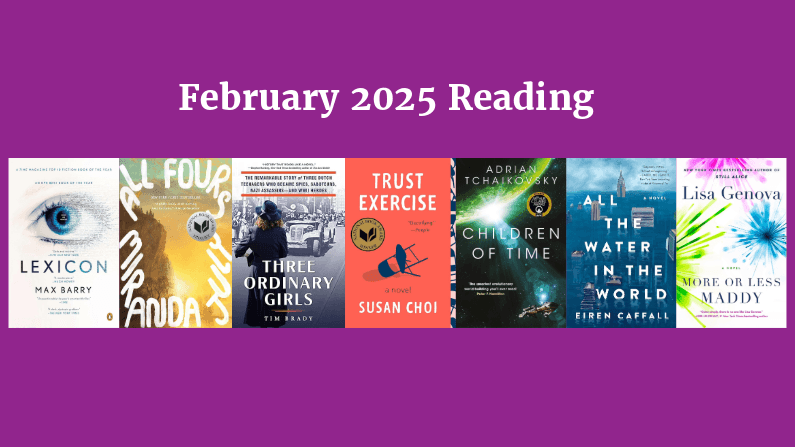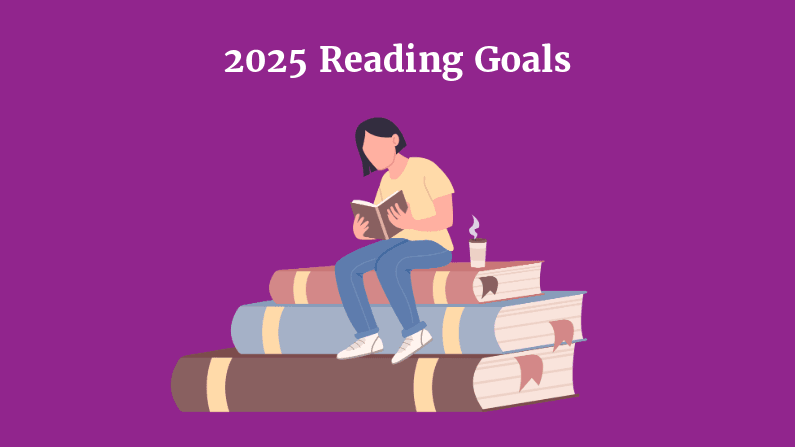Introduction

Embroidering Animals with Color and Texture is the author’s second book on animal embroidery designs. (Her previous book was Animal Embroidery Workbook.) This book expands on the previous one by including information on stumpwork, which are embroidery techniques that create a 3D effect. Some examples include raised stitches, felt bases, and wire slips.
The book includes color photos and diagrams throughout, which is very helpful for seeing what the finished projects will look like and exactly what stitches and colors are used in the patterns.
The book is divided into two parts. Part 1 focuses on Getting Started, while Part 2 includes the actual projects.
Part 1: Getting Started

This finished gecko project shows how “stumpwork” can add dimension to an embroidery project
Chapter 1 covers topics such as materials and supplies, including embroidery fabric, hoops, stencils, floss, needles, and other helpful items. Supplies and tools used for stumpwork are also included. The author also discusses transfer tools that are needed to transfer the book’s patterns to embroidery fabric.
Chapter 2 discusses how to put fabric in a hoop, thread a needle, bind a hoop, correct mistakes, anchor floss, and transfer designs to fabric.
Chapter 3 focuses on stumpwork techniques, such as adding beads, incorporating padding, and creating wire slips.
Chapter 4 provides instructions for 43 different embroidery stitches. Each stitch has a short written description and diagram showing how to perform the stitch. At the end of the chapter, there is a longer section on how to use the long and short stitch for thread painting.
Chapter 5 focuses on how to finish work in a hoop, as well as tips for framing and embroidering on clothes.
Part 2: Critter Projects
Part 2 includes the 25 critter projects, which are sorted into four categories. A tutorial on how to read the patterns is included. Each pattern includes a list of suggested DMC floss colors, a list of required materials, a stitch and color diagram, guidance on stitch direction, a full-color photo of the finished project, step-by-step instructions for each section of the project (with photos), and a full-page breakdown of the colors and where they are used in the pattern.
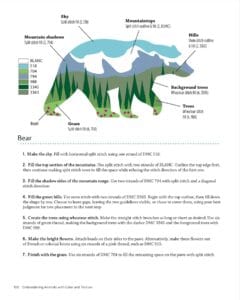
Instruction Page
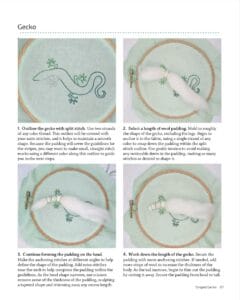
Instruction Page
The projects start with 6 Easy Beginner projects featuring these animals: bluebird, seahorse, dolphin, dove, fish, and beetles. These projects are designed for beginners and use beginner stitches but often in challenging ways. There are suggestions for substitutions and variations to simplify the projects.
The next set of projects features 7 Confident Beginner projects, which are a bit more complicated and involve more time and patience. Some of these projects incorporate padding to create a 3D effect. The animals featured in these projects include a gecko, snake, deer, bumblebee, elk, bear, and ringtail.
The book then provides 6 Beginner Thread Painting projects. Animals include a penguin family, birds, monarch butterflies, coyote, snail, and meerkat.
After mastering the beginning thread painting projects, readers can move on to 6 more challenging Thread Painting projects that blend more colors and add stumpwork elements. The animals in these projects include axolotls (a type of endangered amphibian that looks like a salamander), dragonfly, raccoon, bunny, tufted titmouse, and piglet.
The last pages of the book are black and white versions of the patterns used in the book. The patterns are the actual size of the projects featured in the book, but guidance on resizing the patterns is provided at the start of Part 2 at the end of “How To Read The Patterns” section.
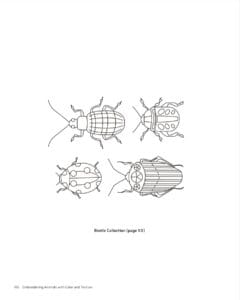
Black and White Pattern for Transfer
My Thoughts
I love that this book provides a mix of animal designs that are creative and attractive. There are more “traditional” projects (like the bluebird sampler) mixed with more unusual approaches (such as the forest elk, mountain bear, and desert coyote).
I like that this book focuses on techniques to add dimension and texture to embroidery projects that seem like they are actually “doable.” The gecko and snake both look like they pop off the fabric, and I loved the dragonfly design where it looks like the dragonfly landed on the fabric to rest for a bit. The thread painting technique results in realistic looking animals, such as the bunny, raccoon, and piglet.

Desert Coyote Project
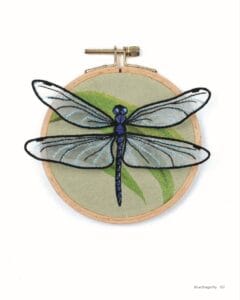
Dragonfly project where the dragonfly looks like it is resting on the fabric
Although it may take me some time to feel the confidence to tackle some of the more challenging projects in this book, I like that the author provides tips for simplifying the projects. In addition, the projects are sorted into different skill levels so the user can attempt new stitches, skills, and techniques with some of the more ambitious projects.
If you’re looking to take your embroidery to a new level by incorporating 3D elements or just want some attractive animal patterns to embroider, I think this book provides a nice mix for both beginners and more advanced embroidery enthusiasts. With detailed instructions on how to transfer and embroider the 25 unique patterns, you’re really getting a bargain by purchasing this book.
My thanks for NetGalley and Landauer Publishing for a review copy of this book.


